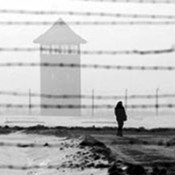
A network of forced labor camps of the OGPU of the USSR created
July 11, 1929 was issued the Decree of the Council of People's Commissars (SNK) of the USSR "On the employment of criminal prisoners," under which began the formation of a network of labor camps (ITL), which was later called the "Gulag" (General Directorate of forced labor camps, labor settlements and places of detention of OGPU) and which became a key element of the political repressions of the Soviet Union.
When the Soviet rule formed, the majority of prison management was entrusted to the punitive department under the People's Commissariat of Justice, established in May 1918. July 25, 1922 the Soviet of People's Commissars adopted a Resolution on the concentration of the management of the main places of detention (except for general prisons) in a single agency, and in October that year there was created a single body in the structure of the People's Commissariat of Internal Affairs (NKVD) – The Main Prison Administration
In July 1929, the Resolution of SNK of the USSR "On the employment of criminal prisoners" was issued. Among the first major labor camps set up shortly after the publication of the resolution, was the Siberian Special Purpose Camp of the Joint State Political Department (OGPU) of the USSR - SIBLON formed in autumn 1929 in the territory of Western Siberia. In 1935, SIBLON was renamed to Siblag.
April 25, 1930, pursuant to the resolution of SNK of the USSR "Regulations on forced labor camps" (7 April 1930), under the Order of the OGPU there was organized the Camps Department of OGPU (ULAG), which in 1934 was renamed to the General Directorate of camps, labor settlements and places of detention (Gulag). The same year Siblag was merged with the Gulag. Later, the General Directorate of camps was renamed twice, and in February 1941 was given the final name - the General Directorate of Corrective Labor Camps and Colonies of the NKVD of the USSR.
April 7, 1942 was formed the Siberian labor camp of the NKVD in Mariinsk, which included several branches: Arlyuk, Antibess, Berikul, Orlov-Rozov, Novo- Ivanovo, Suslov, Yurga and Mariinsk. In the labor camp was established three categories of the regime for prisoners: a strict, a strengthened and a general. Strict regime provided for the most dangerous criminals convicted of banditry, armed robbery, premeditated murder, escape from prison, and for old offenders. They were under heavy surveillance, were not subject to be released from escort and were used mainly for heavy physical work; they were subject to the most severe penalties for refusing to work, for violations of the camp regime. Those sentenced for "political crimes" were also classified as high-risk prisoners.
A medium security was applied to prisoners sentenced for robbery and other dangerous crimes, recidivist thieves. These prisoners were not subject to be released from escort either and were used primarily for general works.
Other prisoners of labor camps and all those who were in penal labor colonies followed the general regime: it allowed them to be released from escort, to be used for basic administrative work in the office of camp and colony units, as well as to be involved in guard and escort services for the surveillance of prisoners
After the end of the Great Patriotic War, in connection with the reorganization of People’s Commissariats to ministries, in March 1946 the General Directorate of forced labor camps and colonies was made part of the Ministry of Internal Affairs of the USSR.
Lit.: Галкин Н. В., Гвоздкова Л. И., Берлинтейгер Б. И. и др. Неизвестный Кузбасс (1943-1991 гг.) : Сб. архивных документов. Тоталитарная система. Палачи и жертвы / Государственный архив Кемеровской области. Кемерово, 1995; Гвоздкова Л. И. Принудительный труд: Исправительно-трудовые лагеря в Кузбассе (30-50-е годы). Кемерово, 1994; Иванова Г. М. ГУЛАГ в советской государственной системе, конец 1920-х — середина 1950-х гг. : дис. ... д. и. н. М., 2002; Кокурин А. И., Петров Н. В. ГУЛАГ (Главное управление лагерей). 1918-1960. М., 2002; Красильников С. А. Серп и Молох: крестьянская ссылка в Западной Сибири в 1930-е годы. М., 2009; Лебедев В. А. СибЛАг. М., 2008; То же [Электронный ресурс]. URL: http://dlib.rsl.ru/viewer/01004144047#?page=1; Лопатин А. А. Главное управление внутренних дел Кемеровской области. 1917-2002 гг.: Страницы истории. Кемерово, 2002; Марченко С. Г. Страницы истории уголовно-исполнительной системы Кемеровской области. Кемерово, 2009; Павлов С. М. Кузбасская Голгофа. Кемерово, 2008; Панов Ю. П. Сиблаг ГУЛАГа: документальное повествование. Кемерово, 2005; Система исправительно-трудовых лагерей в СССР : Справочник. М., 1998; Упадышев Н. В. Гулаг на Европейском Севере России: генезис, функционирование, распад: 1929-1960 гг. : автореф. дис. ... д. и. н. Архангельск, 2009.
Based on the Presidential Library’s materials:
Материал подготовлен при участии Кемеровской областной научной библиотеки имени В. Д. Фёдорова

